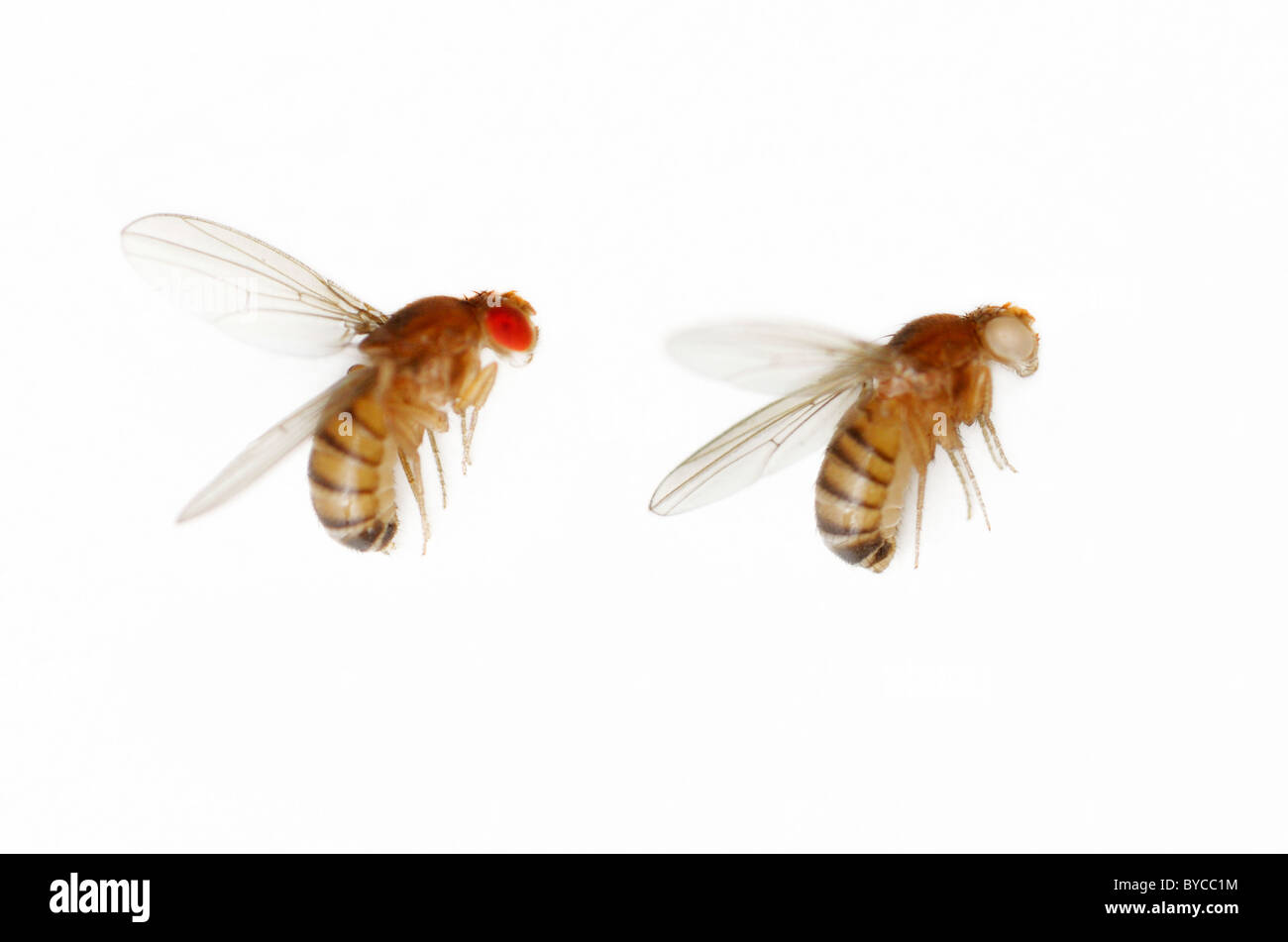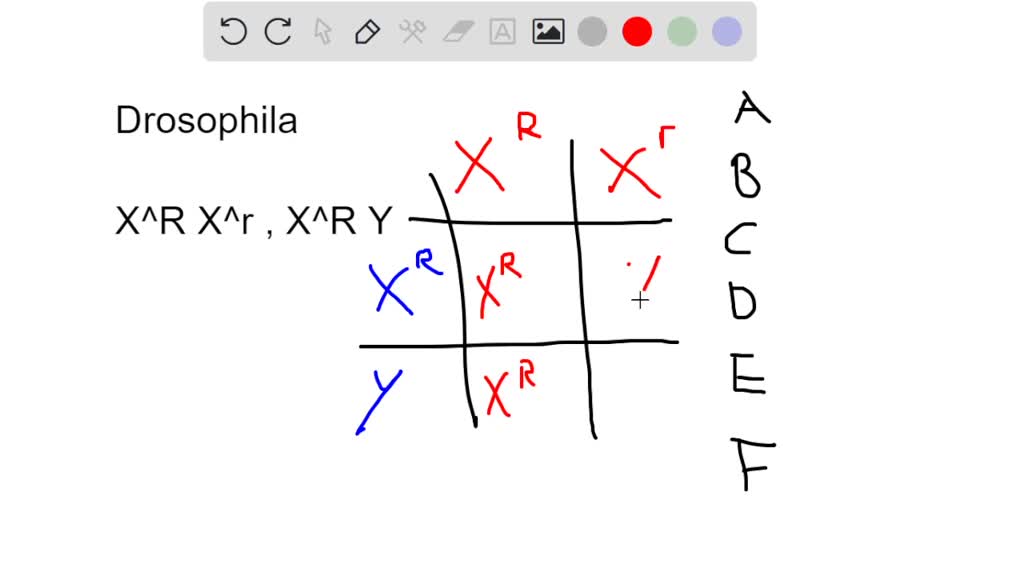Have you ever wondered why certain traits seem to skip generations or appear more frequently in one gender than the other? The answer lies in the fascinating world of genetics, specifically in the concept of X-linked inheritance. Drosophila melanogaster, commonly known as the fruit fly, has become a model organism for this type of genetic analysis due to its readily observable and easily manipulated traits, most notably eye color. By studying the inheritance of eye color in these little creatures, we gain valuable insights into the intricate mechanisms of genetic transmission.

Image: www.alamy.com
To truly understand X-linked inheritance, we need to delve into the fundamental concepts of chromosomes and genes. Chromosomes are thread-like structures within the nucleus of every cell, carrying our genetic blueprint. Genes, the functional units of heredity, reside on these chromosomes. Humans, as well as fruit flies, possess two types of sex chromosomes: X and Y. Females typically have two X chromosomes (XX), while males have one X and one Y chromosome (XY). This makes the X chromosome the key player in the inheritance of X-linked traits.
Unveiling the Mystery of Eye Color Inheritance
Drosophila eye color is a classic example of an X-linked trait. In wild-type fruit flies, the dominant allele for eye color, w+, produces red eyes. A recessive allele, w, results in white eyes. The gene responsible for this trait is located on the X chromosome, making it an X-linked gene. This means that the inheritance patterns for eye color differ between males and females.
Since males only have one X chromosome (XY), they inherit only one copy of the eye color gene. Therefore, a male fruit fly will exhibit the phenotype (observable trait) determined by the allele present on his single X chromosome. If he inherits the wild-type allele w+, he will have red eyes. Conversely, if he inherits the recessive allele w, he will have white eyes.
Females, on the other hand, have two X chromosomes (XX). They inherit one X chromosome from their mother and one from their father. Therefore, females carry two copies of the eye color gene. If a female inherits two copies of the wild-type allele w+, she will have red eyes. She will also have red eyes if she inherits one w+ allele and one w allele because w+ is dominant over w. Only if a female inherits two copies of the recessive allele w will she express the white eye phenotype. This is because the recessive allele is only expressed in the absence of the dominant allele.
Understanding the Crosses
To illustrate these concepts, let’s consider a hypothetical cross. Imagine a female fruit fly with red eyes (w+ w+) is mated with a male fruit fly with white eyes (wY). The female will contribute one w+ allele to all her offspring, while the male will contribute either a w+ allele (if he inherited it from his mother) or a w allele (if he inherited it from his mother). All the female offspring (XX) will inherit one w+ allele from their mother and one w+ allele or one w allele from their father, resulting in either w+w+ or w+w genotypes, making them all red eyed. Half of the male offspring (XY) will inherit the w+ allele from their mother and will have red eyes. The other half will inherit the w allele from their mother and will have white eyes.
Drosophila Eye Color: More Than Just Red and White
The simple dichotomy of red and white eyes doesn’t entirely encompass the fascinating range of eye color variations observed in Drosophila. Over the years, researchers have identified several other mutations influencing eye color, including:
- Cinnabar (cn): A mutation resulting in bright, reddish-orange eyes. This mutation affects the production of a specific enzyme required for the formation of red pigment.
- Brown (bw): A mutation causing a brown pigment to accumulate in the eyes, resulting in brown eyes.
- Vermilion (v): A mutation leading to a darker red pigment, producing a deep reddish-purple eye color.
Interestingly, these mutant alleles can interact with each other, producing a diverse spectrum of eye colors. For instance, the combination of the cn and bw alleles results in a bright yellow eye color, demonstrating the complex interplay between different genetic factors in determining eye color.

Image: www.numerade.com
Applications of X-linked Inheritance
The study of X-linked inheritance in Drosophila has far-reaching implications beyond the curiosity of fly genetics. This model organism has been instrumental in unraveling complex genetic principles, contributing to our understanding of human diseases with X-linked inheritance patterns. Examples include:
- Hemophilia: An X-linked recessive disorder affecting blood clotting. Males with the hemophilia allele on their single X chromosome exhibit the disease, while females are typically carriers, meaning they possess one copy of the normal allele and one copy of the hemophilia allele.
- Duchenne Muscular Dystrophy: An X-linked recessive disorder leading to progressive muscle weakness and degeneration. Similar to hemophilia, males with the affected allele on their X chromosome develop the disease, while females are typically carriers.
Drosophila research has proven invaluable in identifying genes implicated in these human diseases and in understanding how mutations affect the gene’s function, paving the way for potential therapeutic interventions. Beyond human disease, the principles of X-linked inheritance also find applications in agriculture and animal breeding. For example, identifying genes associated with desirable traits like milk production in dairy cattle or egg production in chickens can be facilitated by studying X-linked inheritance patterns in these organisms.
Drosophila Eye Color Is An X Linked Trait
https://youtube.com/watch?v=T0X2hWZArSE
From Fruitfly to Human, a Shared Genetic Legacy
By studying the seemingly simple trait of eye color in the humble fruit fly, we gain profound insights into the nature of inheritance and how genetic information is transmitted from one generation to the next. This knowledge is fundamental to understanding both human health and the evolution of life on Earth. The meticulous and insightful research performed on Drosophila has not only unraveled the mysteries of X-linked inheritance but has also illuminated broader principles that apply across diverse species, including humans. Next time you see a fruit fly, remember the remarkable genetic legacy it carries – a legacy that continues to contribute to our understanding of the intricate workings of life.






